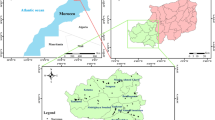Abstract
This study was aimed at establishing a water quality database in the study area where none existed previously. Groundwater samples from bore-holes, hand-pump, and hand-dug wells of four densely populated towns in South-Western Nigeria were analyzed in respect to physicochemical factors, biological factors, and the metals Nickel (Ni), Lead (Pb), Cadmium (Cd), Zinc (Zn), Copper (Cu), and Iron (Fe) for six consecutive months from September 2012 to February 2013 to give mean values for each town and water source. Total aerobic plate, total coliform bacteria, and Escherichia coli (E. coli) were detected in most of the water samples from the different towns and sources considered. Except for total suspended solids and total solids, the physicochemical parameters of all the samples were within permissible limits. The concentrations Pb, Ni, Cr, and Cd were above the minimum permissible limits. The presence of coliforms and E. coli in the groundwater samples indicates fecal contamination. The microorganisms isolated in this study include Enterobacteriaceae, Staphylococcus aureus, E. coli, Citrobacter, Klebsiella, Pseudomonas, Bacillus, and Micrococcus species. The analysis of variance of data obtained from this study shows that bore-hole water samples were safer for drinking that water samples from hand-pump, and hand dug wells across the communities.




Similar content being viewed by others
References
Afeni TB (2008) Assessment of flood control in an open pit mine-Sagamu experience. J Eng Appl Sci 3(9):708–717
APHA (1992) Standard methods for examination of water and waste-water, 18th edn. American Public Health Association, Washington, DC
APHA (2012) Standard methods for examination of water and waste-water, 22nd edn. American Public Health Association, Washington, DC
Dahunsi SO, Oranusi SU, Ishola RO (2012) Bioaccumulation pattern of cadmium and lead in the head capsule and body muscle of Clariasgariepinus [Burchell, 1822] exposed to paint emulsion effluent. Res J Environ Earth Sci 4(2):166–170
Domènech L, Saurí D (2011) A comparative appraisal of the use of rainwater harvesting in single and multifamily buildings of the Metropolitan Area of Barcelona (Spain): social experience, drinking water savings and economic costs. J Clean Prod 19:598–608
Khan S, Shahnaz M, Jehan N, Rehman S, Shah MT, Din I (2012) Drinking water quality and human health risk in Charsadda district, Pakistan. J Clean Prod. doi:10.1016/j.jclepro.2012.02.016
Mora A, Mac-Quhae C, Calzadilla M, Sanchez L (2009) Survey of trace metals in drinking water supplied to rural populations in the eastern Llanos of Venezuela. J Environ Manage 90:752–759
Obi CN, Okocha CO (2007) Microbiological and physicochemical analysis of elected bore-whole in World Bank Housing Estate, Umuahia, Abia State Nigeria. J Eng Appl Sci 2(5):920–929
Okorafor KA, Agbo BE, Johnson AM, Chiorhe M (2012) Physicochemical and bacteriological characteristics of selected steams and borehole in Akankpa and Calabar municipality, Nigeria. Arch Appl Sci Res 4(5):2115–2121
Owamah HI (2013) Biosorptive removal of Pb(II) and Cu(II) from wastewater using activated carbon from cassava peels. J Mater Cycles Waste Manag. doi10.1007/s10163-013-0192-z
Owamah HI, Asiagwu AK, Egboh SHO, Phil-Usiayo S (2013) Drinking water quality at Isoko North communities of the Niger Delta Region, Nigeria. Toxicol Environ Chem. doi:10.1080/02772248.2013.847939
Shittu OB, Olaitan JO, Amusa TS (2009) Physicochemical and bacteriological analysis of water used for drinking and swimming in Abeokuta, Nigeria. Afr J Biomed Res 11:228–290
Tamasi G, Cini R (2004) Heavy metals in drinking waters from Mount Amiata(Tuscany, Italy). Possible risks from arsenic for public health in the Province of Siena. Sci Total Environ 327:41–51
Udoessien EI (2003) Basic principles of environmental science. Etiliew Ltd., Uyo
Ukpong EC, Okon BB (2013) Comparative analysis of public and private borehole water supply sources in Uruan Local Government Area of Akwa-Ibom State. Int J Appl Sci Technol 3(1):76–91
USEPA (1977) Toxicology of metals. In: Research environmental health effects series, vol II. United States Environmental Protection Agency, Washington, DC
USEPA (2007) Technology transfer network: chromium compounds. United States Environmental Protection Agency, Washington, DC
Uzoigwe CI, Agwa OK (2012) Microbiological quality of water collected from boreholes sited near refuse dumpsites in Port Harcourt, Nigeria. Afr J Biotechnol 11(13):3135–3139
WHO (1993) Guidelines for drinking water quality. In: Recommendations, vol. 1. World Health Organization, Geneva
WHO (1996) Guidelines for drinking water quality, vol II, 2nd edn. World Health Organization, Geneva
WHO (2006) Guidelines for drinking water quality, vol I, 3rd edn. Recommendations. First addendum to 3rd edition. World Health Organization, Geneva
Author information
Authors and Affiliations
Corresponding author
Rights and permissions
About this article
Cite this article
Dahunsi, S.O., Owamah, H.I., Ayandiran, T.A. et al. Drinking Water Quality and Public Health of Selected Towns in South Western Nigeria. Water Qual Expo Health 6, 143–153 (2014). https://doi.org/10.1007/s12403-014-0118-6
Received:
Revised:
Accepted:
Published:
Issue Date:
DOI: https://doi.org/10.1007/s12403-014-0118-6




